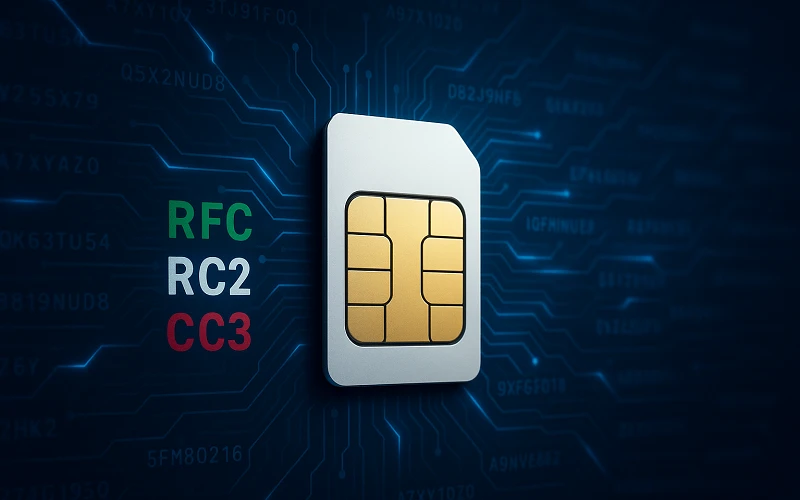It looks like a Mexican RFC (tax ID) for a company.
Here’s why, how it’s built, and what you can (and can’t) learn from it—explained in plain US English.
Quick context: What is an RFC?
In Mexico, every taxpayer gets an RFC (Registro Federal de Contribuyentes). It’s the official tax identification number used on invoices, bank forms, payroll, and filings. Mexico’s tax authority (SAT) issues it and defines its structure. Individuals use a 13-character RFC; companies (legal entities) use a 12-character RFC.
Why SIM980216FQ8 looks like a company RFC
A company RFC (called persona moral) has this pattern:
3 letters taken from the company’s legal name
6 digits for date of incorporation in YYMMDD
3 alphanumeric characters called the homoclave (a tie-breaker code)
That gives 12 total characters. SIM980216FQ8 fits this pattern exactly: SIM + 980216 + FQ8.
Note: Individuals (called personas físicas) have 13 characters: 4 letters from the person’s names + YYMMDD birth date + homoclave. That does not match our 12-character string
Breaking down SIM980216FQ8
| Slice | What it likely is | Meaning in RFC rules |
|---|---|---|
| SIM | Name code | First 3 letters derived from a company’s legal name (or standardized acronym) |
| 980216 | Date | YYMMDD → 1998-02-16 (Feb 16, 1998) as an incorporation date (or registration date used by SAT) |
| FQ8 | Homoclave | 3-character code SAT assigns to avoid duplicates |
These fields mirror SAT’s public descriptions and third-party documentation of RFC format for legal entities.
So… what are the “secrets” behind it?
There isn’t a hidden message. The “secret” is that it’s an ID with a recipe:
Name-based prefix: “SIM” hints at how SAT condensed a company’s legal name.
A date: “980216” reads like 16 February 1998 in RFC format.
A unique tail: “FQ8” is a homoclave—an automatic code that ensures uniqueness if two entities would otherwise share the same first 9 characters.
That’s it. No password. No unlock key. Just a tax identifier that follows Mexico’s rules.
Can you verify SIM980216FQ8 online?
SAT RFC Validator: SAT maintains an official validator portal. You can input an RFC to check if it’s valid/recognized. It uses a CAPTCHA, so it must be checked by a person in the browser.
Business software (Microsoft/Oracle, etc.) also documents the 12 vs 13 character rule and provides examples of valid shapes. This helps you spot real-looking formats (though it won’t confirm a specific company).
Important: Format-correct ≠ officially assigned. A string can “look right” but still not belong to a real taxpayer. Only SAT’s own systems (or compliant integrators connected to SAT) can tell you if that exact RFC is active and who it belongs to.
Secondary concepts, in simple terms
Mexican tax ID (RFC)
SAT Mexico (the tax authority)
Homoclave (the last 3 characters)
Legal entity / Company (persona moral)
Date code (YYMMDD)
RFC validation
These are the right ideas to search and read about—without keyword stuffing.
How the RFC for companies is built (visual guide)
Pattern: LLL YY MM DD HHH
LLL= 3 letters from the company nameYYMMDD= Incorporation date (year-month-day)HHH= Homoclave (letters or digits)
Example from vendor docs: OME910101TA3 (shape and logic only; not related to our code).
Rule sources you can trust:
SAT/SHCP information sheets and forms that describe 12 characters for companies and 13 for individuals.
OECD’s TIN guide for Mexico, confirming the two structures.
Practical explainers by fintech and compliance providers.
What you cannot infer from SIM980216FQ8
The full legal name of the company.
Its current status (active, canceled, merged).
Its address or owners.
Any private data.
For those, you would need official documentation (e.g., an e-invoice stamped by SAT) or a search on SAT systems by an authorized party.
Practical tips if this code appeared in your workflow
Check the format first. For a company, count 12 characters and look for the YYMMDD middle section.
Validate with SAT if you need to rely on it (CAPTCHA required; do it in your browser).
Match the date: If a supplier claims they incorporated in 2015 but the RFC shows 980216, ask for clarification.
Ask for a CFDI (Mexican e-invoice) from the party. A valid CFDI will display the RFC that SAT accepted for that transaction.
Avoid assumptions: Don’t treat a format-correct RFC as proof of identity. Always verify against official or contractual documents.
Short comparison table (company vs. individual)
| Type | Total length | Letters up front | Date inside | Homoclave | Typical use |
|---|---|---|---|---|---|
| Company (Persona moral) | 12 | 3 letters from company name | YYMMDD incorporation | 3 alphanumeric | Invoices, contracts, filings |
| Individual (Persona física) | 13 | 4 letters from names | YYMMDD birth date | 3 alphanumeric | Payroll, invoices, filings |
Authoritative descriptions of both structures appear in SAT/OECD docs and mainstream vendor guidance.
Is there public chatter about SIM980216FQ8?
Yes—strings that look like SIM980216FQ8 sometimes pop up in social posts or scraped lists on the web, often without context. That doesn’t prove authenticity; it only shows that users mention it. Always check with SAT or request proper documents.
Key takeaways
SIM980216FQ8 matches the 12-character shape of a Mexican company RFC.
The middle 980216 looks like Feb 16, 1998 in YYMMDD form.
The tail FQ8 is a homoclave that ensures uniqueness.
A correct format alone does not prove that the code is valid, active, or belongs to a specific firm.
To rely on it, validate via SAT and request supporting documents.
FAQs
1) Is SIM980216FQ8 definitely a real, active RFC?
Not necessarily. It looks valid in format, but only SAT can confirm status or ownership. Use the official validator or obtain a SAT-stamped document (like a CFDI) from the party.
2) Can I decode the full company name from “SIM”?
No. “SIM” is only a 3-letter reduction from the legal name. Many names could reduce to “SIM.” You need official paperwork to know the exact entity.
3) Does “980216” always mean 1998-02-16?
In RFC rules, the date segment is YYMMDD. So “980216” maps to Feb 16, 1998 when used for companies. But you still need context and validation to rely on it.
4) What is the homoclave and why does it matter?
The homoclave (here, FQ8) is a 3-character code that SAT assigns to avoid duplicates when the first nine characters collide across taxpayers. It doesn’t reveal extra info by itself.
5) How can I validate an RFC if I’m outside Mexico?
You can use SAT’s public validator in your browser (it requires a CAPTCHA), or work with vendors who have lawful integrations to check RFCs. Many accounting/ERP systems also enforce the 12 vs 13 structure to flag obvious typos.
Bottom line: The “secret” behind SIM980216FQ8 is that it follows Mexico’s standard tax-ID recipe for companies. Treat it like any tax ID: verify it, document it, and don’t assume more information than the format provides.




